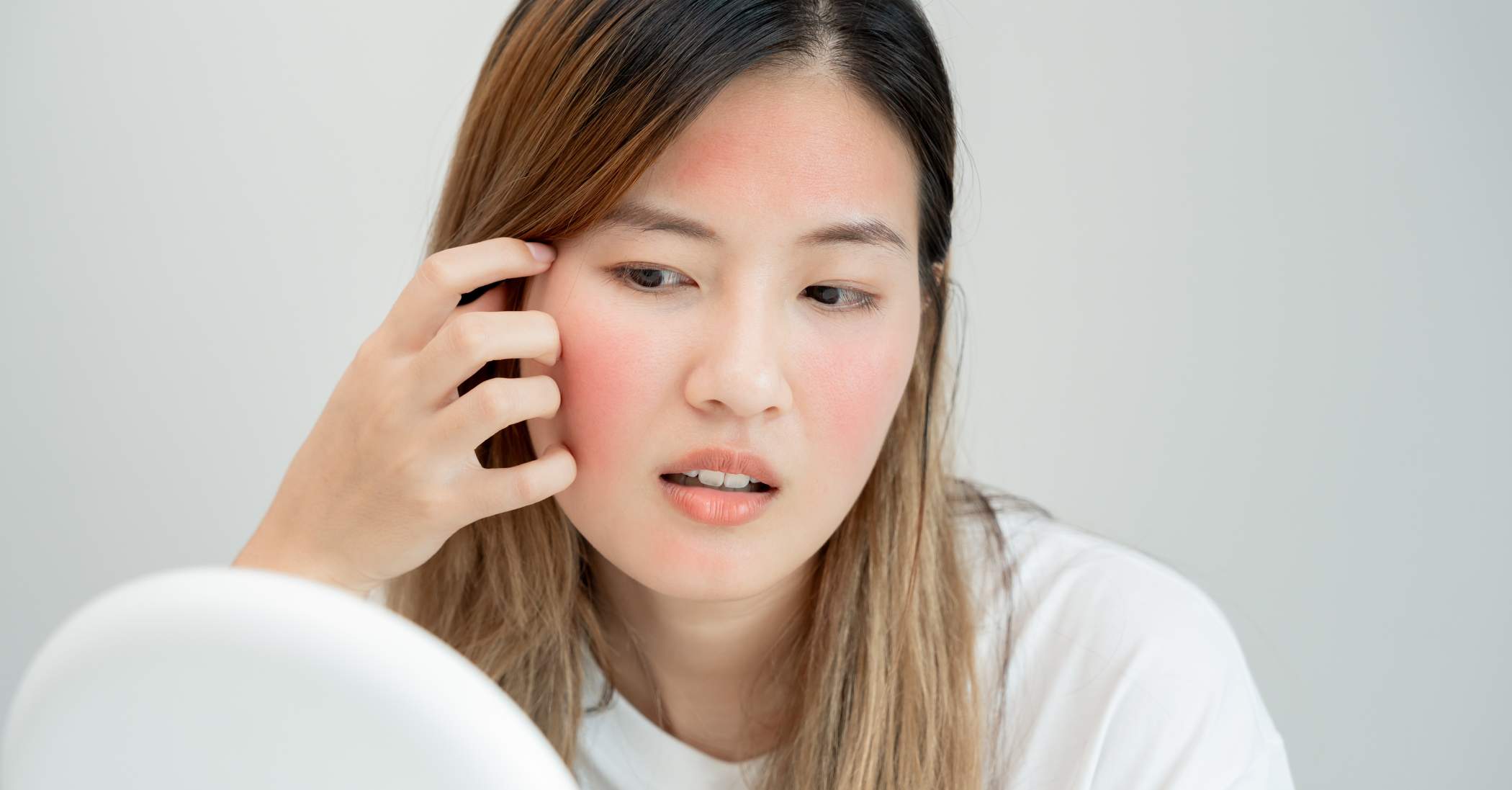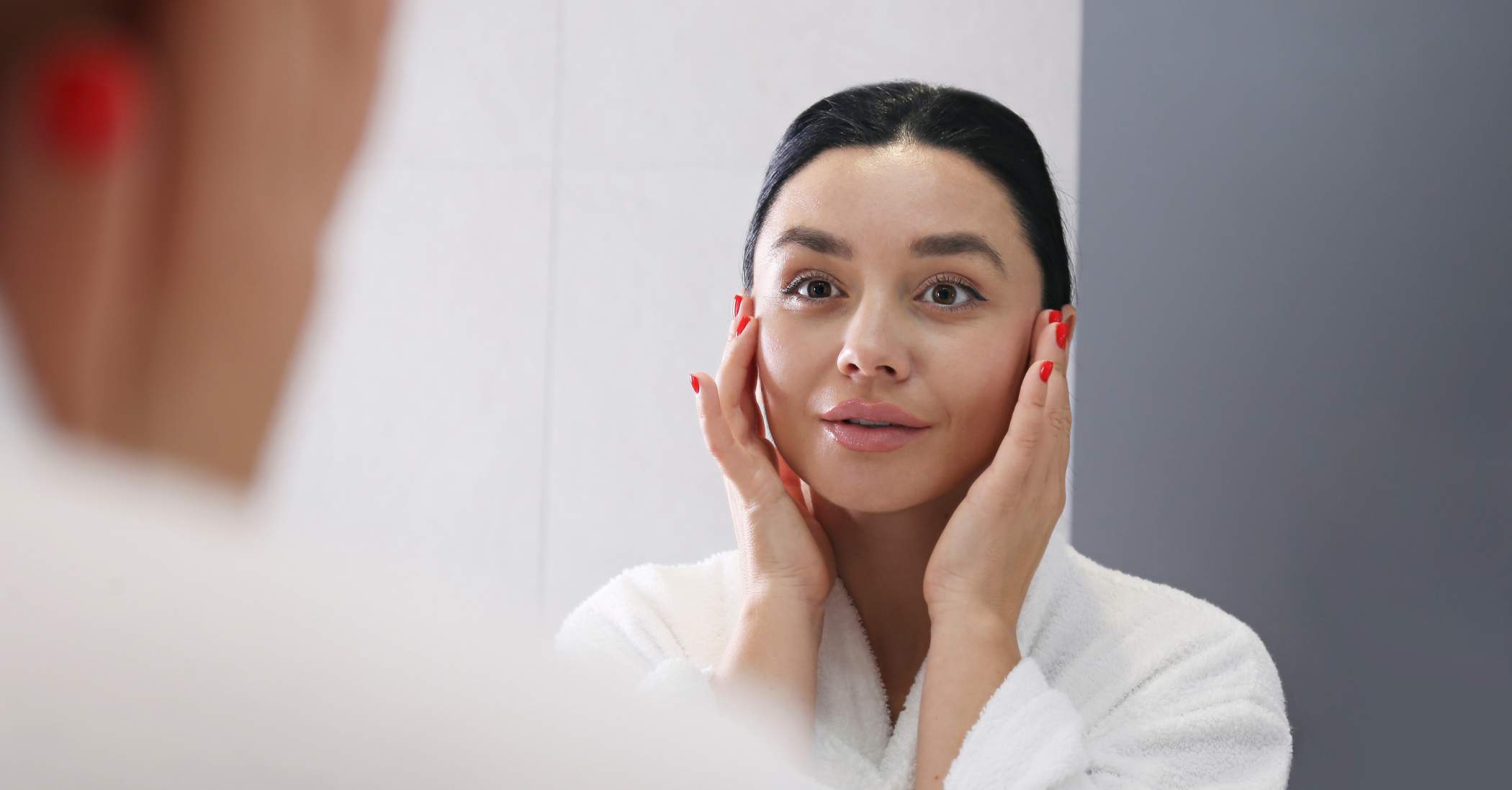Rosacea is a common yet often misunderstood skin condition that primarily affects the face. It causes redness, irritation, and visible blood vessels, and can range from mild redness to more severe symptoms like bumps, pustules, and eye problems.
Although the exact cause of rosacea remains unclear, it is believed to be triggered by a combination of genetic and environmental factors. Recognizing the symptoms is essential for early detection and effective treatment.
In this blog, we’ll explore the key signs of rosacea, how to identify them, and practical steps you can take to manage this condition.
Five Key Symptoms of Rosacea
Rosacea symptoms can vary greatly from person to person, but some key signs are frequently observed. Recognizing these early can help you seek effective treatment.
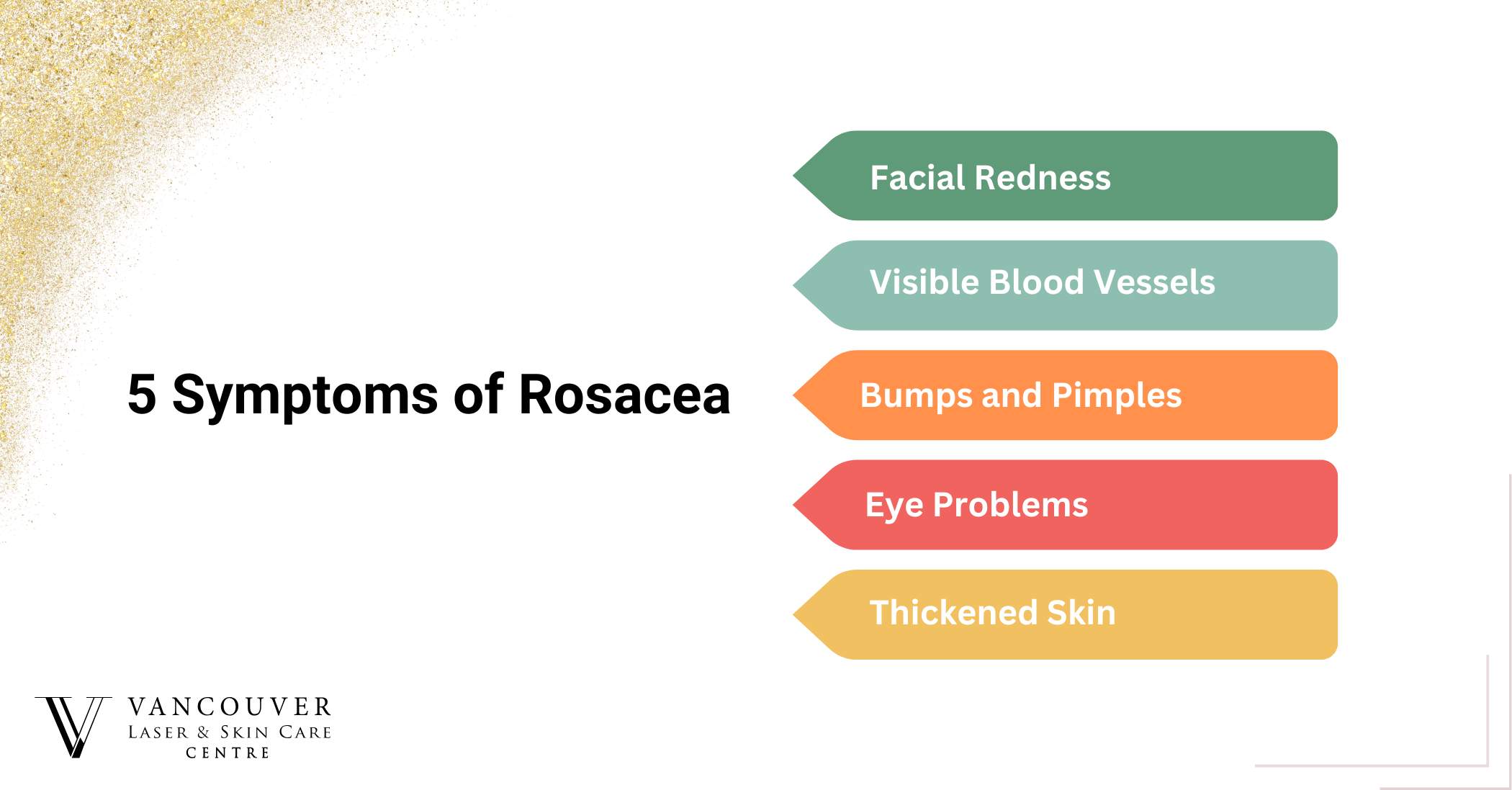
Facial Redness
The most common symptom is persistent redness, particularly in the central areas of the face, including the cheeks, nose, chin, and forehead. This redness may come and go but often becomes more noticeable over time.
Visible Blood Vessels
Rosacea can cause small, visible blood vessels—known as telangiectasia—to appear on the skin, especially on the nose and cheeks. These vessels often look like tiny red or purple lines that are difficult to conceal.
Bumps and Pimples
Small, red, pus-filled bumps resembling acne may develop on the face. Unlike acne vulgaris, these bumps lack blackheads or whiteheads, making them distinct.
Eye Problems
Ocular rosacea affects the eyes, causing redness, irritation, dryness, and occasionally blurry vision. Left untreated, it can result in more severe issues requiring medical attention.
Thickened Skin
In advanced cases, rosacea may cause thickened, coarse skin, especially around the nose—a condition called rhinophyma. This symptom is more common in men and can significantly alter facial appearance.
Conditions Often Mistaken for Rosacea
It’s essential to differentiate rosacea from other skin conditions, such as acne and eczema. While these conditions may share similarities, their distinct characteristics require different treatment approaches.
Acne
Acne is characterized by blackheads, whiteheads, pimples, and cysts. While rosacea can cause acne-like breakouts, it typically affects the central part of the face and is accompanied by redness, flushing, and visible blood vessels.
Eczema
Eczema is a chronic condition that causes dry, itchy, and inflamed skin. Although both rosacea and eczema can result in redness and irritation, eczema generally affects larger areas of the body and is often associated with severe itching.
Types of Rosacea
Rosacea is a complex skin condition with four main types, each presenting distinct symptoms and triggers. Some individuals may experience more than one type simultaneously. Understanding these variations can guide treatment and help manage symptoms effectively.
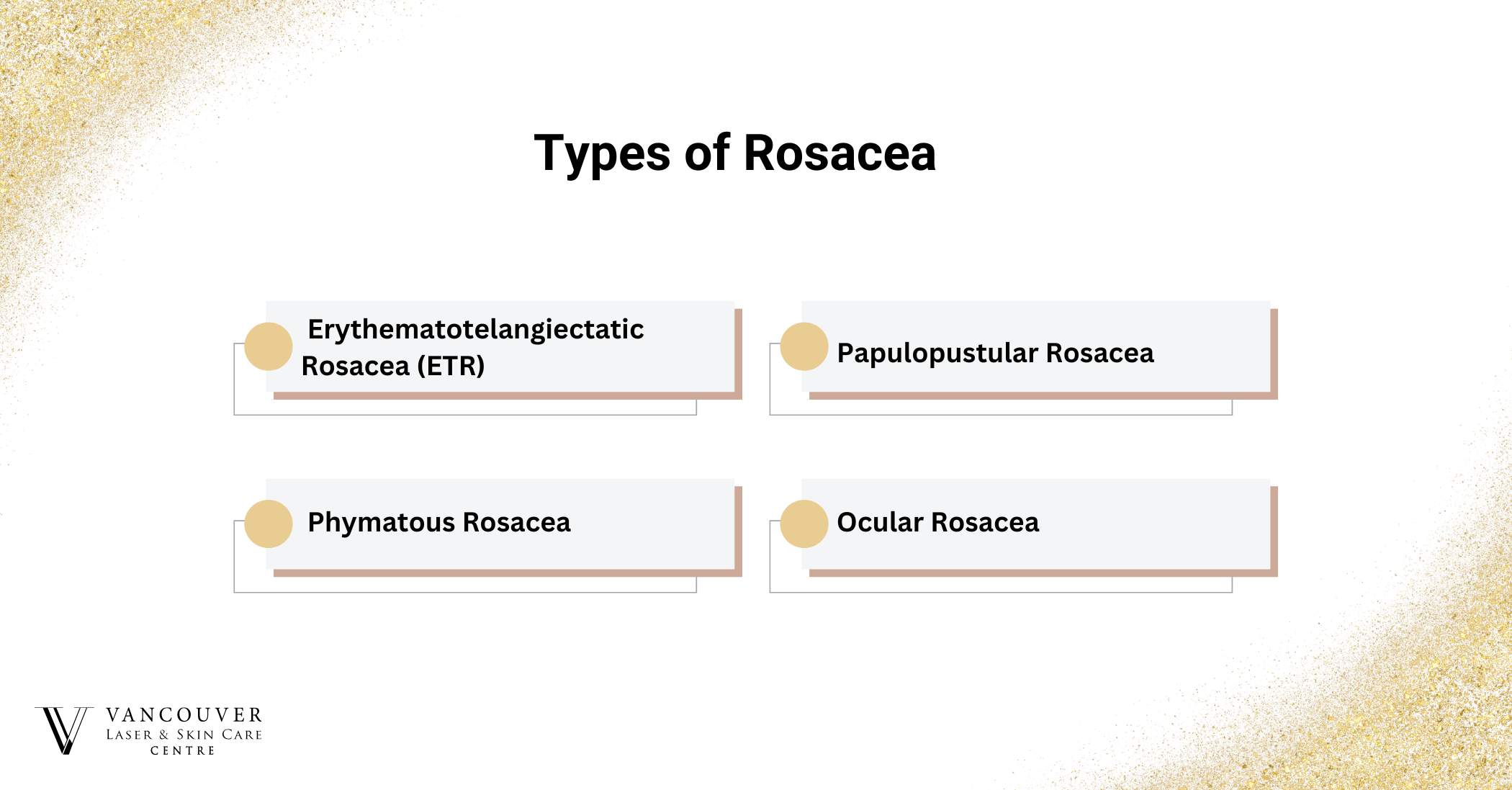
Erythematotelangiectatic Rosacea (ETR)
ETR is the most common form of rosacea, characterized by persistent redness or flushing on the central face, particularly the cheeks, nose, and forehead. Visible blood vessels (telangiectasia) or a tendency to blush easily are also common. Triggers include sun exposure, hot drinks, spicy foods, and alcohol.
Papulopustular Rosacea
This type involves red, inflamed bumps or pimples resembling acne. These bumps, often surrounded by redness, can appear on the cheeks, nose, forehead, and chin. Unlike acne, papulopustular rosacea does not involve blackheads or whiteheads. Heat, spicy foods, and stress are common triggers.
Phymatous Rosacea
Phymatous rosacea is an advanced form of the condition where the skin thickens and becomes bumpy. This type primarily affects the nose (rhinophyma) but may also involve the chin or forehead. The skin appears swollen, enlarged, and rough. It is more prevalent in men than women.
Ocular Rosacea
Ocular rosacea impacts the eyes, causing redness, dryness, irritation, and a gritty sensation. Left untreated, it may lead to severe eye issues. Symptoms include swollen eyelids, light sensitivity, and blurred vision. Ocular rosacea often accompanies other rosacea types and requires prompt management to prevent complications.
How to Manage Rosacea Symptoms
Managing rosacea symptoms involves a combination of lifestyle changes, gentle skincare, and medical treatments. While rosacea is a chronic condition, the right approach can help significantly reduce flare-ups and keep your skin healthy. Here’s how to manage rosacea effectively:
Adopt a Gentle Skincare Routine
- Use mild, non-abrasive cleansers to avoid irritating your skin.
- Opt for fragrance-free products, as fragrances can trigger flare-ups.
- Choose soothing moisturizers that maintain the skin’s natural barrier, avoiding products with alcohol or harsh chemicals.
Use Sunscreen Daily
Sun exposure is a major cause of rosacea flare-ups. Apply sunscreen every day, even during cloudy weather. Choose a broad-spectrum sunscreen with SPF 30 or higher to protect against UVA and UVB rays. Wearing a wide-brimmed hat and seeking shade can provide added protection.
Make Dietary Modifications
Certain foods and drinks, such as spicy foods, hot beverages, alcohol, and sugary or fatty foods, can worsen rosacea symptoms. Reduce or eliminate these triggers from your diet. Incorporate fruits, vegetables, and whole grains to support overall skin health.
Stress Management
Stress is a common rosacea trigger. Regularly practice stress-relief techniques such as meditation, yoga, or deep breathing exercises. Finding effective ways to manage stress can help reduce symptoms and improve your overall well-being.
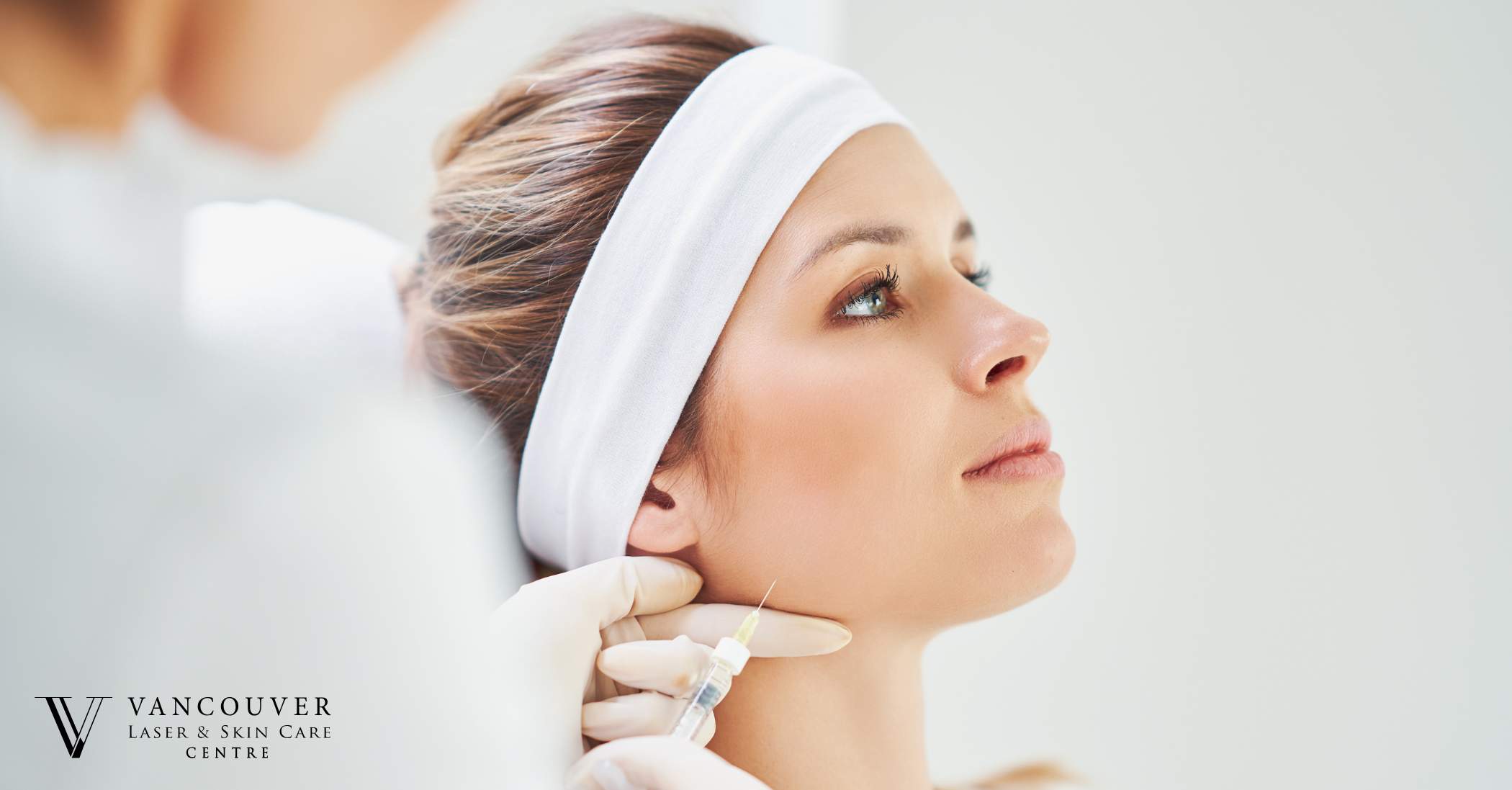
Consider Medical Treatments
For more severe symptoms, dermatologists may recommend medical treatments, including:
- Topical Medications: Metronidazole, azelaic acid, or ivermectin can help reduce redness and inflammation.
- Oral Medications: Antibiotics like doxycycline or oral isotretinoin are often prescribed for severe cases.
- Laser Therapy: Treatments like Intense Pulsed Light (IPL) or Pulsed Dye Laser (PDL) can target redness and visible blood vessels, offering long-term relief.
If you’re struggling with rosacea or noticing its symptoms, don’t hesitate to seek professional help. At Vancouver Laser & Skin Care Centre, our expert team offers personalized treatments to help you manage and reduce rosacea symptoms. . Contact us today to schedule a consultation and begin your journey to clearer, healthier skin!
At our clinic, we offer advanced treatments to effectively manage rosacea, including PicoWay®, ClearLift™, and BBL™ (BroadBand Light).
- PicoWay®: Uses laser pulses to reduce redness and improve skin texture.
- ClearLift™: A gentle, non-ablative treatment that decreases inflammation and strengthens the skin.
- BBL™ (BroadBand Light): Utilizes light energy to address redness, visible blood vessels, and uneven pigmentation, promoting a more radiant complexion.
These treatments are safe, effective, and tailored to your unique skin needs, providing long-lasting results and helping you achieve clearer, healthier skin. Visit our updated rosacea treatment page to learn more about how we can help manage your symptoms.
FAQs
1. What causes rosacea?
The exact cause of rosacea is unclear, but factors like genetics, environmental influences, and certain microorganisms may play a role in its development.
2. Can diet trigger rosacea?
Yes, foods and beverages such as alcohol, spicy dishes, and caffeine can trigger flare-ups in some individuals. Identifying and avoiding your triggers is key.
3. Can stress worsen rosacea?
Stress can aggravate rosacea symptoms. Practising stress-relief techniques like meditation, yoga, or deep breathing can help minimize flare-ups.
4. Is rosacea contagious?
No, rosacea is not contagious. It cannot be spread through physical contact, sharing personal items, or airborne transmission.
5. At what age does rosacea typically develop?
Rosacea most commonly develops in adults aged 30 to 50, though it can appear earlier or later depending on individual factors.
